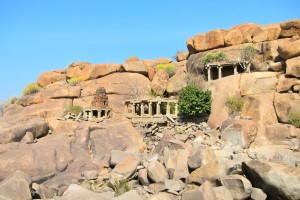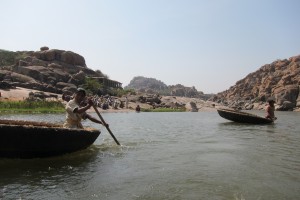Nature vs. nurture
 What was most immediately amazing about Hampi, seat of the medieval Vijayanagar empire and World Heritage Site that A and I recently visited, was its sheer scale—everywhere you turn there are hills strewn with stone doors, pillars, temples, walls… and it stays like that for miles in every direction. This is not some isolated temple or summer estate used rarely by a royal family; this is a sprawling metropolis.
What was most immediately amazing about Hampi, seat of the medieval Vijayanagar empire and World Heritage Site that A and I recently visited, was its sheer scale—everywhere you turn there are hills strewn with stone doors, pillars, temples, walls… and it stays like that for miles in every direction. This is not some isolated temple or summer estate used rarely by a royal family; this is a sprawling metropolis.
It is remarkably beautiful, dumbfoundingly large. And yet, as A and I neared the eighth straight hour of ruin-gazing at the end of our first day, I felt more and more strongly the absence of something: I was fascinated, entranced, but not moved, not transported. The place held no charge. No matter how hard I tried, I could not picture it being lived in. It was, both literally and metaphorically, stony.
 On our second day we rose early and, after a plate of idli sambar, started out again. We took a boat across the river, cut through some mango fields, and climbed up to a temple on top of a hill, said to be the birthplace of Hanuman. I don’t know how old the structure was; it was impossible to tell. We spent some time talking to the priest, who was as excited to speak with us (in Hindi) as we were with him. A praised the feel of the temple, which was tranquil, comfortable, and full, but Babaji refused to take any credit for it. He said his job was not to create anything, but rather to ensure that nothing interfered with the atmosphere that already existed there, to simply enable the natural arc of the place to continue on.
On our second day we rose early and, after a plate of idli sambar, started out again. We took a boat across the river, cut through some mango fields, and climbed up to a temple on top of a hill, said to be the birthplace of Hanuman. I don’t know how old the structure was; it was impossible to tell. We spent some time talking to the priest, who was as excited to speak with us (in Hindi) as we were with him. A praised the feel of the temple, which was tranquil, comfortable, and full, but Babaji refused to take any credit for it. He said his job was not to create anything, but rather to ensure that nothing interfered with the atmosphere that already existed there, to simply enable the natural arc of the place to continue on.
I found myself wishing that the rest of Hampi had been maintained with the same philosophy. Wasn’t it possible to preserve structures and moods at the same time? If so, then was it a shortcoming of the Archaeological Survey of India that they had drained the ruins of Hampi of their vibrancy for the sake of preservation? Or–and I realized this explanation was more likely–was it my shortcoming that I held such romanticized expectations of Hampi as a place of living history, mystery, electricity, and on top of it all, ready access?
This debate is on in Hampi in another way. To support the influx of tourists, the town has built up right in the middle and sometimes even inside of the ruins. A local told us the government recently tore down all the shops in the main strip of the bazaar, citing illegal encroachment. They’re currently considering a plan to shift the entire town to a site 6km away, where there won’t be any temptation or possibility to seep back out into protected space.
 One of the last places we visited was a Surya (Sun) temple on the banks of the river. A few large boulders had fallen nearby, so we had to stoop low, almost crawling our way toward the entryway. The temple was small, maybe 15 square feet. By Hampi standards it was modest so it surely saw fewer visitors, though it was still delicate and lovely. You can only visit the temple a few months out of the year; every monsoon it is submerged in the river. Every winter, when the water drains away, it leaves behind piles of sand and damp mud on the temple floor. Each wall held one or two carvings of some god or goddess, and the pillars in the middle were covered in ornamental designs of flowers, dancers, and elephants.
One of the last places we visited was a Surya (Sun) temple on the banks of the river. A few large boulders had fallen nearby, so we had to stoop low, almost crawling our way toward the entryway. The temple was small, maybe 15 square feet. By Hampi standards it was modest so it surely saw fewer visitors, though it was still delicate and lovely. You can only visit the temple a few months out of the year; every monsoon it is submerged in the river. Every winter, when the water drains away, it leaves behind piles of sand and damp mud on the temple floor. Each wall held one or two carvings of some god or goddess, and the pillars in the middle were covered in ornamental designs of flowers, dancers, and elephants.
The temple was quiet, peaceful, organic, sublime. It was designed to be subject to the elements. No board of overseers could stop the river from rising, nor do I think, by the logic of their own policies, could they justify moving the temple away from its original location. Here, to preserve is not to control but to leave alone. If only it could always be so simple.






